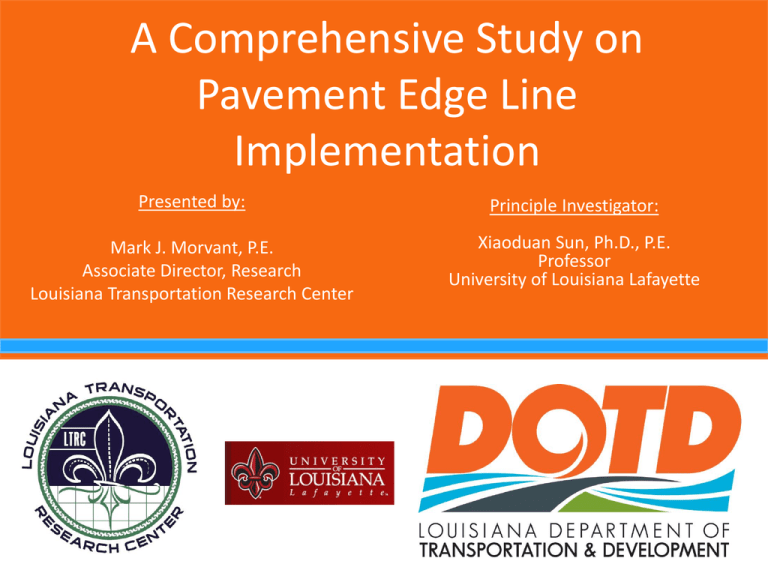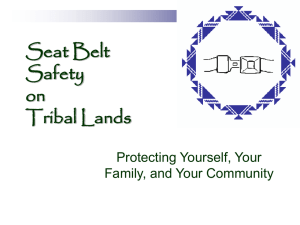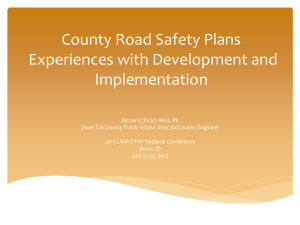Safety Improvement from Edge Lines on Rural Two
advertisement

A Comprehensive Study on Pavement Edge Line Implementation Presented by: Principle Investigator: Mark J. Morvant, P.E. Associate Director, Research Louisiana Transportation Research Center Xiaoduan Sun, Ph.D., P.E. Professor University of Louisiana Lafayette Problem Statement Problem: Will complying with the MUTCD 2000 regarding edge line implementation increase head on collisions on narrow rural roads in Louisiana. • 5,600 miles of narrow, rural two-lane highways in Louisiana (20-22 feet width) • Majority of accidents: Vehicle left the roadway to roll over or impact objects, such as trees, utility poles, bridge walls, embankments, or guardrails. • Almost 60 percent of total fatal crashes occurred when their vehicles veered from the lane. In some cases, the vehicle crossed the centerline and was involved in a head-on crash or opposite direction sideswipe. Project Goals/Objectives Impact of Edge Lines on Safety of Rural TwoLane Highways 2005 Safety Improvement from Edge Lines on Rural TwoLane Highways 2012 Goal: To investigate if marking edge lines would have any negative effect on drivers behavior that could in turn decrease highway safety Goal: To investigate the safety impact of edge lines on narrow, rural two-lane highways by analyzing crash frequencies before and after edge line implementations on a group of selected narrow, rural two-lane highways from all LADOTD districts. Study on Pavement Edge Line Implementation 2014 Goal: To validate 2012 study and perform cost benefit analysis of implementing the safety impact of pavement markings on rural twolane highways in Louisiana. Research Performed 2005 • • • • Documented the results of past and present research and the current practices Investigated driver behavior under various roadway alignment and traffic conditions Examined the potential tort liability Developed a recommended guideline 2012 • Implement pavement edge lines at selected locations (lane widths 20-22 feet) – – – • Nine districts 28 control sections 109 miles Conduct a before-and-after study at these locations to estimate the crash reduction factors – Crash data available for only one year after 2014 • • • • Validated crash results with additional two years of crash data on edge line projects Update crash reduction factors using Empirical Bayes (EB) method Conducted crash characteristics analysis Conducted cost-benefit analysis Research Results • Placing pavement edge lines on rural two-lane highways can not only change vehicle lateral positions but can also reduce crashes. • Estimated crash modification factor (CMF) is 0.85, which means there is a 15% expected crash reduction in edge line implementation. (estimated standard deviation for the CMF is 0.039) • The crash reduction is consistent in all crash types and particularly significant in single vehicle crashes. • Most of single vehicle crashes are Run off Road crashes which is the specific target group for the edge line implementation. Research Recommendations • Use of edge lines on narrow, rural two-lane highways whenever it is financially and operationally feasible. • Since each LADOTD district bears the responsibility of implementing pavement markings, LADOTD may want to establish a policy asking each district to implement edge lines if sufficient resources are available. • Under financial or operational constraints, roadways with higher traffic volumes and higher crash frequencies should have priority to have edge lines implemented. Implementation Strategy • DOTD’s future plan on improving the safety of rural twolane highways includes the application of edge lines. • LADOTD Traffic Engineering Management to update the LADOTD’s PM standards • DOTD Safety Management is actively seeking more safety funds for each district to conduct systematic edge line striping projects on narrow rural two-lane highways Value of Implementing Research 15% reduction is crashes : conservative benefit/cost = 19:1 Crash Reduction Cost including loss of quality of life* Savings from averted crashes Fatal Crash Injury Crash -1 83 Property Damage Only 52 $4,376,304 $137,670 $11,426,610 $3,292 $171,184 Total Benefit** Cost per lane mile Total cost Benefit-cost ratio $11,597,794 Paint (DOTD) Paint (Contractor) $450 $98,676 117 $700 $153,496 75 Thermoplastic (Contractor) $2800 $613,984 19 * LA Safety Annual Report ** Statistical increase in the fatalities due to a high number in 2010 considered a rare event and excluded from calculation Return on Investment Impact of Edge Lines on Safety of Rural Two-Lane Highways Research Project Cost $125,000 Safety Improvement from Edge Lines on Rural Two-Lane Highways $107,060 Study on Pavement Edge Line Implementation $54,214 Total Research costs $286,274 Total Benefit Return on Investment $11,597,794 $11,597,794 40 : 1 A Comprehensive Study on Pavement Edge Line Implementation Mark J. Morvant, P.E. Associate Director, Research mark.morvant@la.gov www.ltrc.lsu.edu/publications LTRC project numbers: 13-2P, 07-7P, 03-6P






